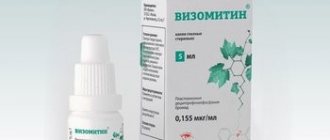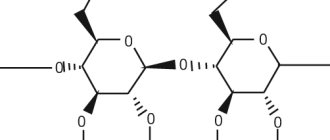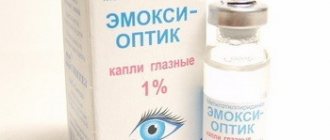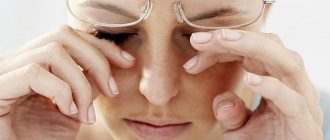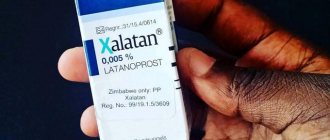Pharmacological action of Tobradex
The effect of the combined drug Tobradex is determined by the active components included in its composition.
Tobramycin, which is part of Tobradex, is a broad-spectrum antibiotic (aminoglycoside group), exhibiting activity against gram-positive and gram-negative microorganisms:
- Staphylococcus spp., including Staphylococcus aureus, Staphylococcus epidermidis and strains exhibiting resistance to penicillin;
- Streptococcus spp., including some group A β-hemolytic species;
- Some strains of Neisseria spp.;
- Some non-hemolytic species and some strains of Streptococcus pneumonia;
- Escherichia coli;
- Pseudomonas aeruginosa;
- Enterobacter aerogenes and Klebsiella pneumonia;
- Proteus mirabilis;
- Proteus vulgaris;
- Morganella morganii and Acinetobacter calcoaceticus;
- Haemophilus influenza and Haemophilus aegyptius;
- Moraxella lacunata.
Dexamethasone, the second active component of Tobradex, is one of the glucocorticosteroid drugs with pronounced anti-inflammatory, antiallergic and desensitizing effects.
Tobradex has an antiexudative effect. When applied topically, absorption of active components is low.
Composition and release form
Tobradex is produced by the Belgian pharmaceutical company Alcon-Couvreur NVSA. It is a white suspension, odorless and free from foreign matter, which separates during storage.
Tobradex is packaged in 5 ml plastic bottles with a built-in dispenser pipette. Each is enclosed in a cardboard box along with detailed instructions for use. The active ingredients of the suspension are the antibacterial agent tobramycin and the glucocorticosteroid dexamethasone. The auxiliary composition is represented by the following ingredients:
- sodium and benzalkonium chlorides;
- tyloxapol;
- hydroxyethylcellulose;
- sulfuric acid and (or) sodium hydroxide to create optimal pH;
- disodium edetate;
- anhydrous sodium sulfate;
- purified water.
Excipients act as stabilizers and promote rapid absorption of tobramycin and dexamethasone. They ensure their uniform distribution in the ocular structures. Thanks to this, the antibacterial and anti-inflammatory effects of the drops are somewhat enhanced and prolonged.
The Tobradex therapeutic line also includes a thick, transparent ointment with an identical active composition. Unlike the suspension, ophthalmologists prescribe it more often for chronic infectious and inflammatory eye lesions.
The drug is also available as an eye ointment.
Pharmacological properties
Corynebacteria, staphylococci, and streptococci have not developed resistance to the effects of tobramycin. The antibiotic destroys Haemophilus influenzae and Escherichia coli, Klebsiella, anaerobic diplococci Moraxella catarrhalis, and enterobacteria. Even atypical pathogens are sensitive to it: chlamydia and mycoplasma.
Another active ingredient in the drops, the glucocorticosteroid dexamethasone, also has pronounced therapeutic properties:
- anti-inflammatory. This component of Tobradex disrupts the synthesis of prostaglandins from arachidonic acids, mediators of pain and inflammation. It helps reduce capillary permeability and resolve swelling;
- immunosuppressive. Dexamethasone prevents the proliferation of lymphocytes and the formation of cytokines, provides an adequate immune response;
- antiallergic. After instillation of drops, inhibition of histamine release from mast cells and basophils is noted. This leads to a decrease in the sensitivity of effector cells, eliminating itching and swelling of the eyelids.
Due to the complex effect of Tobradex components, the infectious and inflammatory process is weakened. Full blood supply to the eyeball with oxygen and nutrients is restored. And this has a positive effect on the rate of regeneration of the mucous membranes and skin of the eyelids.
The combination of two active ingredients ensures maximum effectiveness of the product
Contraindications
The use of Tobradex is contraindicated:
- For viral diseases of the cornea and conjunctiva, including chickenpox and keratitis, which causes Herpes simplex;
- Against the background of mycobacterial eye infection;
- For fungal eye diseases;
- In conditions after removal of a foreign body of the cornea;
- In case of hypersensitivity to active (tobramycin and dexamethasone) or auxiliary components included in the medication.
Due to insufficient clinical data, the question of the possibility of using Tobradex during pregnancy should be resolved exclusively with the attending physician, who assesses the benefits of the drug and the expected harm to the mother and child. Tobradex is not recommended for use during breastfeeding.
In pediatrics, the use of Tobradex is allowed from the age of 18.
Analogues of the drug
The medicine has many analogues, one of them is a drug produced in Romania, “DexaTorb”, which is completely similar in composition. Eye drops with hormonal drugs and antibiotics in their composition:
- Maxitrol. Country of origin: Belgium. Main components: polymyxin B, neomycin, etc.
- Garazon has an anti-inflammatory effect for keratitis and blepharitis. Reviews about the effectiveness of the medicine are positive.
- Sofradex is an Indian drug based on dexamethasone and framycetin.
- Brumicin. Eye drops produced in Hungary, which have an anti-inflammatory effect.
Directions for use and dosage
Tobradex in the form of eye drops is used every 4-6 hours, instilling 1-2 drops into the conjunctival sac. In some cases, in the first days of treatment, the interval between procedures is reduced to 2 hours.
According to the instructions, Tobradex ointment is used topically 3-4 times a day. As improvement occurs, the frequency of use decreases.
A combination of ointment and drops is possible: ointment is recommended to be used in the evening before bed, and drops throughout the day. At the same time, you should maintain the frequency of use of the medication (3-4 times a day).
special instructions
Tobradex drops contain benzalkonium chloride, which can be absorbed by contact lenses. Before instilling the drug, you must remove contact lenses and put them back 20 minutes or more after instillation.
When using the drug for more than 14 days, monitoring the condition of the cornea is required.
Do not touch the tip of the dropper bottle or tube to any surfaces, otherwise the dropper bottle or tube tip and their contents may become contaminated.
The bottle or tube must be closed each time after use.
In adolescents aged 12–18 years, the duration of treatment with Tobradex drops should not exceed 7 days.
If there is a temporary decrease in vision clarity after using the drug, it is necessary to refrain from driving vehicles and other mechanisms until normal vision is completely restored.
Side effects of Tobradex
Most often, according to reviews, Tobradex causes pain and irritation of the eyes, as well as a feeling of discomfort in the eyes.
Among allergic reactions when using Tobradex, according to reviews, redness of the conjunctiva, itching and swelling of the eyelids are most often observed.
Tobradex can cause systemic reactions such as:
- Headache;
- Dysgeusia;
- Laryngospasm;
- Rhinorrhea.
Among other adverse reactions that occur when using Tobradex, reviews note:
- Keratitis, including punctate;
- Increased intraocular pressure;
- Itching;
- Conjunctival hyperemia;
- Blurred vision;
- Erythema of the century;
- Swelling of the eyelids and conjunctiva;
- Mydriasis;
- Sensation of a foreign body in the eye;
- Increased lacrimation;
- Dry eye syndrome;
- Decreased visual acuity;
- Development of glaucoma and cataracts;
- Photophobia.
With an increase in the number of procedures or prolonged use of Tobradex, intraocular pressure may increase with the possible subsequent development of steroid glaucoma. In addition, in some cases, the development of posterior subcapsular cataracts and a slowdown in wound healing were observed.
During therapy with Tobradex, it should be taken into account that, due to the local immunosuppressive effect of glucocorticosteroids, a secondary bacterial infection may develop, since corneal damage occurs especially often with their long-term use. The development of a secondary infection is indicated by the appearance of non-healing ulcers on the cornea. Also, glucocorticosteroids can mask and intensify the existing infectious process in acute purulent eye diseases.
In case of an overdose of Tobradex according to the instructions, the following may be observed:
- Itching;
- Irritation of the mucous membrane of the eye;
- Swelling of the eyelids;
- lacrimation;
- Conjunctival hyperemia.
For treatment, symptomatic therapy is indicated after the eyes are thoroughly washed with water.
How to choose
How to make the right choice without getting confused in the wide range of products presented? First of all, you need to consult with an ophthalmologist and also study the instructions for using Tobradex.
A replacement medication is most often necessary if there is an individual intolerance to the active substances or allergies. In this case, preference should be given to analogues that have a similar therapeutic effect, but a different composition.
The reason for purchasing an analogue is also the presence of restrictions on the use of Tobradex. The product is not intended for the treatment of viral diseases of the cornea, fungal diseases, or after removing a foreign object from the eyes. You should also choose an alternative when it comes to treating a young child.
Most often, a replacement medication is sought because of its high price. In such cases, it is worth paying attention to the drugs Dexatobropt and Tobrazon, which have a similar composition, but are more affordable.
When purchasing drops, you should make sure that the packaging is intact, check the expiration date, and also read the instructions.
Despite the fact that modern medicines are quite expensive, it is better not to skimp on your health. If a specialist has prescribed a remedy, it means that it is suitable for this particular patient. However, sometimes it is not possible to take it. In this case, analogues will come to the rescue and can become an effective alternative.
Expert opinion
Lyudmila Sheveleva
Higher pharmaceutical education, pharmacist. Work experience in a pharmacy - more than 20 years.
Ask a Question
The therapeutic effect of Tobradex is due to the pharmacological properties of its active ingredients. Tobramycin easily penetrates into bacterial cells. Then it binds to ribosomes, inhibiting the biosynthesis of special proteins. Without them, pathogen replication is impossible. They lose their ability to reproduce and quickly die. Meanwhile, dexamethasone eliminates all discomfort, including itching of the eyelids and sensitivity to bright light. But the list of contraindications for Tobradex is quite wide. There is also a possibility of side effects, so it should be used only as prescribed by an ophthalmologist.
Additional terms
For eye drops, the price in Russian pharmacies can be 390-540 per bottle. The low cost significantly adds to the popularity of Tobradex.
If it is necessary to store the purchased product for a long period of time, it must be provided with temperature conditions in the range of 8-27 degrees. The place where the bottle is located should be protected from small children. The medicine can be used for two years from the date of release. Once the container with the drops is opened, its contents should be used for treatment within a month.
The container with drops is equipped with a convenient device for dosing the liquid solution during procedures. It should be installed in a vertical position.
Tobradex eye drops are sold in pharmacies upon presentation of a prescription.
Tobradex solution can be used for treatment in children starting at the age of 12 years. When prescribing the drug, the doctor must take into account the limitation - the period of use of Tobradex in therapy should not exceed a week.
A few important points
Before you start using Tobradex, there are important instructions to remember. Do not forget to shake the jar of medicine before applying so that the excipients do not settle at the bottom of the container. At the end of use, close the container tightly to protect it from weathering.
Never touch the end of the dispenser to the surface of your eye, as this may cause discomfort. When reflexively closing the eye, this can also reduce the effectiveness of the active components of the drug, creating barriers to the passage of the medicine, and also increase the duration of the manipulations.
Do not forget that after using the product, blurred vision may occur, so you should not drive or operate potentially dangerous machinery until clear vision is fully restored. It is better to find out the most accurate time for restoration of visual abilities from your doctor or other qualified specialist in this field.
Indications for use
Indications for the use of Tobradex drops are the treatment of infectious and inflammatory eye pathologies. It is prescribed to patients when pathogenic microorganisms sensitive to tobramycin are detected in the biomaterial. The drug is included in treatment regimens when diagnosing the following ophthalmological diseases:
- conjunctivitis - inflammatory lesions of the mucous membrane covering the inner surface of the eyelids and sclera;
- keratitis - inflammatory pathologies of the cornea, causing clouding and decreased visual acuity;
- blepharitis - bilateral recurrent inflammation of the ciliary edge of the eyelids.
A local remedy is also used when severe viral keratitis is detected. In this case, it is indicated to prevent bacterial infection of the eyes. For this purpose, the suspension is used in the postoperative period. And also in the complex treatment of injuries - burns or mechanical damage to the cornea.
It responds well to treatment with Tobradex drops and barley. This is the name of the inflammatory process that develops when the hair follicle of an eyelash or sebaceous gland becomes infected. Treatment of barley with a suspension is carried out exclusively after removal of the pus.
Conjunctivitis is one of the main indications for the use of drops
Interaction with other drugs and overdose
The following interactions were identified:
- antibiotics of the aminoglycoside group - increased risk of systemic side effects;
- drugs with ototoxic and nephrotoxic effects – mutual reinforcement.
When using Tobradex in an unacceptable dosage, the following symptoms are recorded:
- swelling and swelling of the eyelids;
- itching and burning;
- conjunctival hyperemia.
In case of overdose, you should rinse your eyes with boiled water at room temperature and seek help from a specialist.
In what cases it is safe and justified to use Tetracycline eye ointment is described in detail in the article.
During pregnancy, any medications can be used only after consultation with a gynecologist.
The fight against glaucoma and its consequences - Timolol eye drops.




